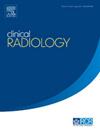使用非冠状动脉专用计划计算机断层血管造影(CTA)评估经导管主动脉瓣置换术(TAVR)患者的旁观者冠状动脉疾病:在回顾性现实世界队列中的诊断准确性
IF 2.1
3区 医学
Q2 RADIOLOGY, NUCLEAR MEDICINE & MEDICAL IMAGING
引用次数: 0
摘要
目的:评估非冠状动脉专用tavr前CT血管造影(CTA)作为前瞻性心电图门控扫描,在评估旁观者冠状动脉疾病(CAD)与有创冠状动脉造影(ICA)作为金标准的诊断潜力。材料和方法:这项回顾性研究纳入了232例患者,他们接受了CTA和ICA作为tavr前评估的一部分。排除标准包括既往支架、起搏器、冠状动脉搭桥术或瓣膜手术。冠状动脉仅通过薄层轴向重建进行分析,观察者对ICA结果不知情。狭窄分为轻度(< 50%)、中度(50%-69%)和重度(≥70%)。计算50%和70%直径狭窄(DS)阈值的敏感性、特异性、阳性预测值(PPV)、阴性预测值(NPV)和诊断准确性。结果:在50% DS阈值下,CTA的敏感性为71%,特异性为74%,NPV为92%,PPV为38%。在70% DS阈值下,结果包括46%的敏感性,91%的特异性,93%的NPV和41%的PPV。50% DS时血管特异性NPV最高的是左主干(98%)和左前降支(91%);70%时,左主干(LM)(98%)和左旋(LCX)(94%)的NPV最高。图像质量影响NPV,具有优秀或非常好的图像质量与更高的诊断性能相关。结论:非冠状动脉专用tavr前CTA有望有效地排除显著的CAD,并可能作为ICA的看门人,与典型的冠状动脉CT血管造影(CCTA)结果一致。本文章由计算机程序翻译,如有差异,请以英文原文为准。
Assessment of bystander coronary artery disease in transcatheter aortic valve replacement (TAVR) patients using noncoronary-dedicated planning computed tomography angiography (CTA): diagnostic accuracy in a retrospective real-world cohort
Aim
To assess the diagnostic potential of a noncoronary-dedicated pre-TAVR CT angiography (CTA) conducted as a prospective ECG-gated scan without premedication and standard cardiac reconstructions in evaluating bystander coronary artery disease (CAD) against invasive coronary angiography (ICA) as the gold standard.
Materials and Methods
This retrospective study included 232 patients who underwent both CTA and ICA as part of their pre-TAVR evaluation. Exclusion criteria included prior stent, pacemaker, coronary artery bypass, or valve surgery. Coronary arteries were analysed solely through thin-slice axial reconstructions, with observers blinded to ICA results. Stenosis was categorised as mild (< 50%), moderate (50%–69%), or severe (≥70%). Sensitivity, specificity, positive predictive value (PPV), negative predictive value (NPV), and diagnostic accuracy were calculated for 50% and 70% diameter stenosis (DS) thresholds.
Results
At the 50% DS threshold, CTA demonstrated 71% sensitivity, 74% specificity, 92% NPV, and 38% PPV. At the 70% DS threshold, results included 46% sensitivity, 91% specificity, 93% NPV, and 41% PPV. The highest vessel-specific NPV at 50% DS was for the left main (98%) and left anterior descending (LAD) (91%); at 70% DS, left main (LM) (98%) and left circumflex (LCX) (94%) showed the highest NPV. Image quality impacted NPV, with excellent or very good image quality linked to higher diagnostic performance.
Conclusion
Noncoronary-dedicated pre-TAVR CTA shows promise for ruling out significant CAD effectively and may act as a gatekeeper for ICA, aligning with typical coronary CT angiography (CCTA) outcomes.
求助全文
通过发布文献求助,成功后即可免费获取论文全文。
去求助
来源期刊

Clinical radiology
医学-核医学
CiteScore
4.70
自引率
3.80%
发文量
528
审稿时长
76 days
期刊介绍:
Clinical Radiology is published by Elsevier on behalf of The Royal College of Radiologists. Clinical Radiology is an International Journal bringing you original research, editorials and review articles on all aspects of diagnostic imaging, including:
• Computed tomography
• Magnetic resonance imaging
• Ultrasonography
• Digital radiology
• Interventional radiology
• Radiography
• Nuclear medicine
Papers on radiological protection, quality assurance, audit in radiology and matters relating to radiological training and education are also included. In addition, each issue contains correspondence, book reviews and notices of forthcoming events.
 求助内容:
求助内容: 应助结果提醒方式:
应助结果提醒方式:


